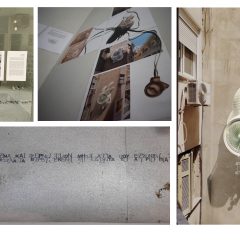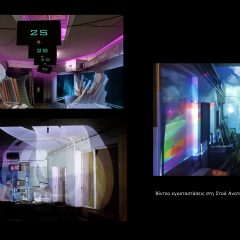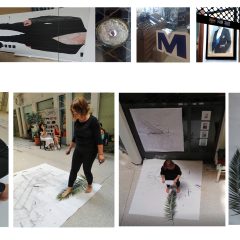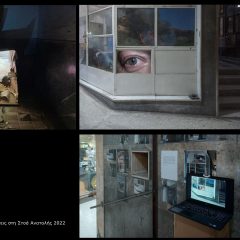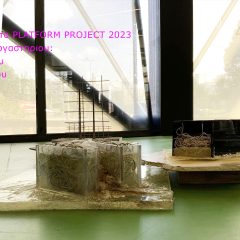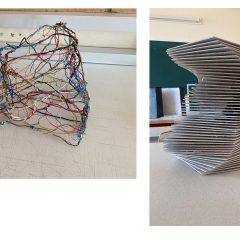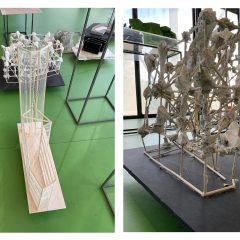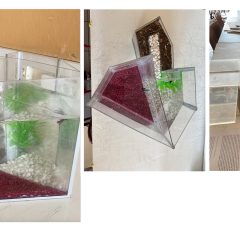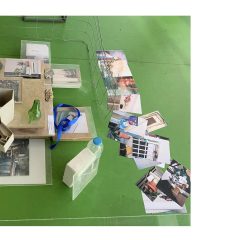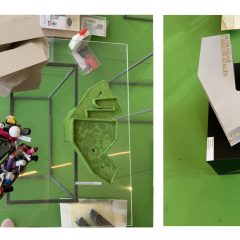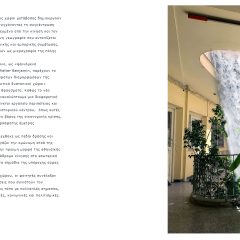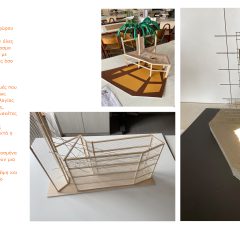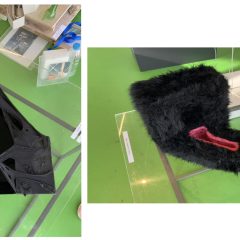General
The course commences from the semantic along with the typological exploration of a certain point (locus) in the urban fabrication of a city. There in it, advances aesthetic forms of interpolation of a creative construction/installation in respect to the scale and the details that are appearing to the actual locus.
Course content
The course brings forth the necessity of structuring a concept, organized within a consistent context – experience (phenomenological/psychological) and develop it as the content of an original artwork. Course gives particular emphasis on communication and presentation of the project
The main strategy that students deploy in order to elaborate their ideas deals with:
A) the task of observation, known as « reading of space»
B) the living experience of the space, registered in «an archive of notes»
C) «the conversation» with the residents of the particular urban-point of study
D) the mapping and the tracing of all those elements that will help them to compose their ideas into a creative but eloquent visual structure («the project»).
C) further investigation may involve: literature searches, site visits, analyses of objects/images/text.
Theory and practice are inseparable throughout the programme. Students are asked to contextualise their work in oral presentations and contextual written report, as well as in project tutorials. Learning is assessed and supported in studio.
Programme aims
The aim of the course lies in:
• the evolution of creative and original ideas
• involving deferent techniques, from digital tools to pure structural forms.
• the understanding of the term «concept» as the key-tool to organize their ideas into designs and yet to unlock the ideas behind the projects they study.
• encourage students to consider and contextualise their process towards cultural, environmental and social subject matters.
• observe critically – and then record, interpret and represent their observations to others.
• researching approach [ means the collection of data/material for analysis and selection in constructing/realizing the project].
Learning Outcomes: Knowledge and Understanding
• enables students to develop an awareness of the opportunities found within other relative areas to architecture like contemporary art
• developing their thinking and creative actions through research and actual experience of the real space in a phenomenological and psychological way.
• develop techniques and skills and use them appropriately in different forms of presentation
• Use of appropriate language in expressing orally and written the main idea behind their work (text structure and layout included)
• be able to connect art and design with visual communication which can be understood within various social/cultural/historical and economic contexts.
• Understand their own work through a historical / theoretical framework
Bibliography
* Bachelard, G. (1969). The poetics of space. Boston: Beacon Press.
* Michel Foucault Of Other Spaces: Utopias and Heterotopias
* Huyssen, A. Present Pasts. Urban Palimpsests and the Politics of Memory, Stanford, Stanford University Press, 2003.
* P. Virilio,. The Aesthetics of Disappearance, Semiotext, 1991
* Bishop Cl. Installation Art. Tate publishing
* Tschumi B. Event Cities, Cambridge MA: The MIT Press, 1994
* R. Barthes (1970,1984). «Centre-ville, centre vide / Κέντρο πόλη, κέντρο κενό»,
* R. Barthes L’empire des signes / Η επικράτεια των σημείων (1970), εκδ. Ράππα.
* B. Ekim, ‘A video projection mapping conceptual design and application: Yekpare’, The Turkish Online Journal of Design, Art and Communication, τ. 1, τχ. 1, Ιουλίου 2011 [Online]. Διαθέσιμο στο: http://www.tojdac.org/tojdac/VOLUME1-ISSUE1_files/v01i102.pdf.
* A. Head, ‘Exploring the issues of digital outdoor architectural projections’, στο Electronic Visualisation and the Arts, S. Dunn, J. Bowen, και K. Ng, Επιμ. London, 2012, σσ 78–85 [Online]. Διαθέσιμο στο: http://ewic.bcs.org/upload/pdf/ewic_ev12_s3paper4.pdf .
* S. Gehring και A. Wiethoff, ‘Interaction with Media Façades’, Informatik-Spektrum,


